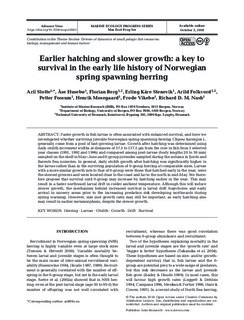| dc.contributor.author | Slotte, Aril | |
| dc.contributor.author | Husebø, Åse | |
| dc.contributor.author | Berg, Florian | |
| dc.contributor.author | Stenevik, Erling Kåre | |
| dc.contributor.author | Folkvord, Arild | |
| dc.contributor.author | Fossum, Petter | |
| dc.contributor.author | Mosegaard, Henrik | |
| dc.contributor.author | Vikebø, Frode Bendiksen | |
| dc.contributor.author | Nash, Richard David Marriott | |
| dc.date.accessioned | 2018-10-08T14:34:32Z | |
| dc.date.available | 2018-10-08T14:34:32Z | |
| dc.date.created | 2018-09-25T09:08:30Z | |
| dc.date.issued | 2018 | |
| dc.identifier.issn | 0171-8630 | |
| dc.identifier.uri | http://hdl.handle.net/11250/2566959 | |
| dc.description.abstract | Faster growth in fish larvae is often associated with enhanced survival, and here we investigated whether surviving juvenile Norwegian spring spawning herring Clupea harengus L. generally come from a pool of fast-growing larvae. Growth after hatching was determined using daily otolith increment widths at distances of 37.5 to 137.5 µm from the core in fish from 3 selected year classes (1991, 1992 and 1996) and compared among post-larvae (body lengths 20 to 30 mm) sampled on the shelf in May-June and 0-group juveniles sampled during the autumn in fjords and Barents Sea nurseries. In general, daily otolith growth after hatching was significantly higher in the larvae rather than in the surviving population of 0-group herring at comparable sizes. Larvae with a more similar growth rate to that of 0-group were those that hatched early in the year, were the slowest growers and were located close to the coast and far to the north in mid-May. We therefore propose that survival until 0-group may increase by hatching earlier in the year. This may result in a faster northward larval drift in colder ambient temperature. Although this will induce slower growth, the mechanism behind increased survival is larval drift trajectories and early arrival in nursery areas prior to the increasing predation risk developing northwards during spring warming. However, size (not growth rate) may still be important, as early hatching also may result in earlier metamorphosis, despite the slower growth. | nb_NO |
| dc.language.iso | eng | nb_NO |
| dc.title | Earlier hatching and slower growth, a key to survival in the early life history of Norwegian spring spawning herring | nb_NO |
| dc.title.alternative | Earlier hatching and slower growth, a key to survival in the early life history of Norwegian spring spawning herring | nb_NO |
| dc.type | Journal article | nb_NO |
| dc.type | Peer reviewed | nb_NO |
| dc.description.version | publishedVersion | nb_NO |
| dc.source.journal | Marine Ecology Progress Series | nb_NO |
| dc.identifier.doi | 10.3354/meps12682 | |
| dc.identifier.cristin | 1613198 | |
| cristin.unitcode | 7431,21,0,0 | |
| cristin.unitcode | 7431,11,0,0 | |
| cristin.unitcode | 7431,22,0,0 | |
| cristin.unitcode | 7431,20,0,0 | |
| cristin.unitname | Pelagisk fisk | |
| cristin.unitname | Bunnfisk | |
| cristin.unitname | Plankton | |
| cristin.unitname | Oseanografi og klima | |
| cristin.ispublished | true | |
| cristin.fulltext | original | |
| cristin.qualitycode | 2 | |
